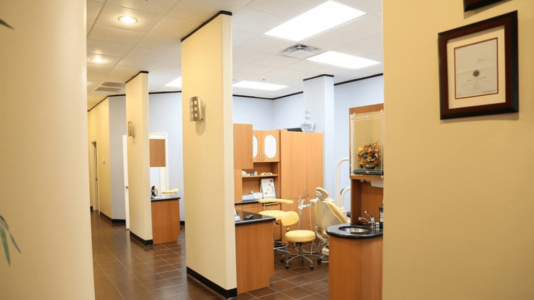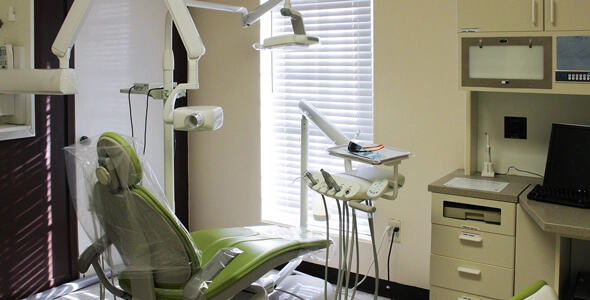At A Dental Care, when a patient has a tooth extraction, we typically recommend dental implants as the best option for tooth restoration. Having dental implants installed following tooth extraction will allow you to get back the appearance and functionality of your missing teeth.
If you’ve recently undergone a tooth extraction or have some questions about dental implants following tooth extractions, you may find this article helpful. We will explain more about how the dental implant procedure works, the advantages and disadvantages of the procedure, and how long after extractions you can have dental implants installed.
If you have any further questions or concerns, feel free to contact any of our offices and our staff will be happy to assist you.
What are Dental Implants?
First of all, before we can discuss the procedure, it’s important that you know exactly what dental implants are. Dental implants consist of three parts:
- Implant (titanium screw inserted into jawbone)
- Abutment (piece that the crown/prosthetic tooth is attached to)
- Crown/Prosthetic tooth
This is a tooth replacement option that is most like your natural teeth and, unless people know that you have them, they won’t be able to tell that they are fake. They are permanently affixed to your jaw. They look, feel, and act like natural teeth.
Dental Implant Procedure Information
Many times, patients are able to get implants at the same time they are having extractions done- but we’ll discuss that more later. Dental implant installation involves inserting the implant into the jawbone so that it’s stable throughout the healing process- which involves the bone fusing with the implant. This will provide the support you need to have your bite fully restored.
There are advantages and disadvantages to having your dental implants installed following tooth extraction.
Advantages
One of the primary advantages of having implants installed on the same day as the tooth extraction surgery is that you won’t need to undergo a second surgery. Once the bad teeth are removed, the dentist will insert the implant right into the empty socket.
If you require additional procedures, such as bone or tissue grafts, this will be done at the same time. This is advantageous because if you have to wait for another surgery to have the implants installed, it increases your treatment period. It also means that treatment will cost more and you’ll have the same chances of success.
Second, having dental implants installed immediately means that you don’t have to worry about going days, weeks, or even longer with a gap in your bite. Having the implant installed immediately gives you back the use of your natural teeth- whether the restoration is temporary or permanent. This means that you’ll be able to speak and eat freely without worrying about anything. Since the technique for placing dental implants has been proven, you don’t have to worry about them shaking or shifting when eating during the healing process.
Finally, you don’t have to worry about bone loss. When you are missing teeth, the jawbone in those areas starts to break down and absorb into your system. However, when the implant is placed, this replaces the tooth root and stimulates the jawbone, keeping it from breaking down.
Disadvantages
Even when the implants are placed at the same time the extractions are done, osseointegration is still critical. The implant must fuse with the jawbone for the procedure to be successful. Full healing may take up to four to six months. During this time, you will be required to follow the dentist’s aftercare instructions carefully. If you don’t, it could cause complications and implant failure.
Though rare, infection may set in or escalate following installation of the implant. This typically happens if the socket is not cleaned properly before the implant is placed. If this happens, it can ultimately result in failure of the implant if not noticed early on.
How Long After Extractions Can Implants Be Placed?
Now that you know more about dental implants, as well as their advantages and disadvantages, let’s consider how long after extractions implants can be placed.
Immediate Placement
As mentioned, dental implant installation is done immediately following extraction. This typically means the implant is done in the same visit, though it may be delayed by a few weeks.
The health of your gums and jaw are critical for immediate placement. If they are not healthy enough, implant placement will have to be delayed until they are. At A Dental Care, we want to make sure we do things right- and if that means delaying implant placement to ensure success, that is what we will recommend.
Early Placement
There are some experts who believe it’s best to place the implant within a few months of the extraction so that your mouth has time to heal and strengthen. If you need bone grafting, this can be done during the waiting period.
We have some patients who don’t want to have a gap in their smile or bite, even for a short time. They want to get their implant done as quickly as possible and while we do understand this, waiting increases your chances of success.
Delayed Placement
If you’ve been missing teeth for some time, you may think that it’s too late for you to get implants and need to seek other tooth replacement options. The good news is that even years after having a tooth extracted, you may still be eligible for dental implants. However, it’s important to note that there are consequences for delayed placement of implants.
After six months, you will begin experiencing bone loss in the extraction area. The neighboring teeth are likely to shift into the gap that was left behind. In fact, it’s even possible to put it off for so long that you won’t be able to get an implant.
Schedule Your Consultation Today
At A Dental Care, we want you to know that it’s never too early- or too late- to talk about dental implants. Contact our office today to schedule your consultation. We would love to discuss your options for tooth replacements, including dental implants, with you.











